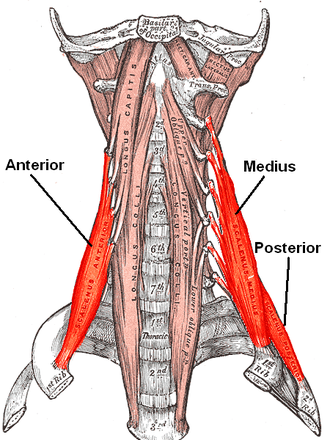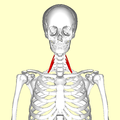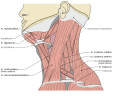| Scalene muscles | |
|---|---|
 The anterior vertebral muscles. | |
| Details | |
| Origin | Cervical vertebrae (CII-CVII) |
| Insertion | First and second ribs |
| Artery | Ascending cervical artery (branch of Inferior thyroid artery) |
| Nerve | Cervical nerves (C3-C8) |
| Actions | Elevation of first and second ribs |
| Identifiers | |
| Latin | mm. scalenii |
| FMA | 64829 |
| Anatomical terms of muscle | |
The scalene muscles are a group of three muscles on each side of the neck, identified as the anterior, the middle, and the posterior. They are innervated by the third to the eighth cervical spinal nerves (C3-C8).
Contents
- Structure
- Anterior scalene
- Middle scalene
- Posterior scalene
- Variation
- Function
- Relations
- Clinical significance
- History
- Etymology
- Additional images
- References
The anterior and middle scalene muscles lift the first rib and bend the neck to the side they are on. The posterior scalene lifts the second rib and tilts the neck to the same side.
The muscles are named from the Ancient Greek σκαληνός (skalēnós), meaning 'uneven'.






